+ Open data
Open data
- Basic information
Basic information
| Entry | Database: PDB / ID: 6gsa | ||||||
|---|---|---|---|---|---|---|---|
| Title | Core Centromere Binding Factor 3 (CBF3) with monomeric Ndc10 | ||||||
 Components Components |
| ||||||
 Keywords Keywords | DNA BINDING PROTEIN / Centromere / CDEIII-binding / LRR domain | ||||||
| Function / homology |  Function and homology information Function and homology informationRAVE complex / Iron uptake and transport / CBF3 complex / regulation of transcription by galactose / regulation of sulfur amino acid metabolic process / cellular response to methylmercury / vacuolar proton-transporting V-type ATPase complex assembly / septin ring assembly / mitotic spindle elongation / centromeric DNA binding ...RAVE complex / Iron uptake and transport / CBF3 complex / regulation of transcription by galactose / regulation of sulfur amino acid metabolic process / cellular response to methylmercury / vacuolar proton-transporting V-type ATPase complex assembly / septin ring assembly / mitotic spindle elongation / centromeric DNA binding / regulation of exit from mitosis / kinetochore assembly / condensed chromosome, centromeric region / regulation of metabolic process / spindle pole body / positive regulation of glucose transmembrane transport / protein neddylation / mitotic intra-S DNA damage checkpoint signaling / vacuolar acidification / silent mating-type cassette heterochromatin formation / mitochondrial fusion / exit from mitosis / DNA binding, bending / SCF ubiquitin ligase complex / SCF-dependent proteasomal ubiquitin-dependent protein catabolic process / FBXL7 down-regulates AURKA during mitotic entry and in early mitosis / mitotic spindle assembly checkpoint signaling / Orc1 removal from chromatin / DNA replication origin binding / cullin family protein binding / Antigen processing: Ubiquitination & Proteasome degradation / subtelomeric heterochromatin formation / regulation of protein-containing complex assembly / spindle midzone / endomembrane system / negative regulation of cytoplasmic translation / regulation of mitotic cell cycle / chromosome segregation / kinetochore / spindle / G1/S transition of mitotic cell cycle / G2/M transition of mitotic cell cycle / mitotic cell cycle / ubiquitin-dependent protein catabolic process / protein-containing complex assembly / chromosome, telomeric region / DNA-binding transcription factor activity, RNA polymerase II-specific / protein ubiquitination / DNA binding / zinc ion binding / identical protein binding / nucleus / cytoplasm Similarity search - Function | ||||||
| Biological species |  | ||||||
| Method | ELECTRON MICROSCOPY / single particle reconstruction / cryo EM / Resolution: 4.2 Å | ||||||
 Authors Authors | Zhang, W.J. / Lukoynova, N. / Vaughan, C.K. | ||||||
| Funding support |  United Kingdom, 1items United Kingdom, 1items
| ||||||
 Citation Citation |  Journal: Cell Rep / Year: 2018 Journal: Cell Rep / Year: 2018Title: Insights into Centromere DNA Bending Revealed by the Cryo-EM Structure of the Core Centromere Binding Factor 3 with Ndc10. Authors: Wenjuan Zhang / Natalya Lukoyanova / Shomon Miah / Jonathan Lucas / Cara K Vaughan /  Abstract: The centromere binding factor 3 (CBF3) complex binds the third centromere DNA element in organisms with point centromeres, such as S. cerevisiae. It is an essential complex for assembly of the ...The centromere binding factor 3 (CBF3) complex binds the third centromere DNA element in organisms with point centromeres, such as S. cerevisiae. It is an essential complex for assembly of the kinetochore in these organisms, as it facilitates genetic centromere specification and allows association of all other kinetochore components. We determined high-resolution structures of the core complex of CBF3 alone and in association with a monomeric construct of Ndc10, using cryoelectron microscopy (cryo-EM). We identify the DNA-binding site of the complex and present a model in which CBF3 induces a tight bend in centromeric DNA, thus facilitating assembly of the centromeric nucleosome. | ||||||
| History |
|
- Structure visualization
Structure visualization
| Movie |
 Movie viewer Movie viewer |
|---|---|
| Structure viewer | Molecule:  Molmil Molmil Jmol/JSmol Jmol/JSmol |
- Downloads & links
Downloads & links
- Download
Download
| PDBx/mmCIF format |  6gsa.cif.gz 6gsa.cif.gz | 378.3 KB | Display |  PDBx/mmCIF format PDBx/mmCIF format |
|---|---|---|---|---|
| PDB format |  pdb6gsa.ent.gz pdb6gsa.ent.gz | 309.9 KB | Display |  PDB format PDB format |
| PDBx/mmJSON format |  6gsa.json.gz 6gsa.json.gz | Tree view |  PDBx/mmJSON format PDBx/mmJSON format | |
| Others |  Other downloads Other downloads |
-Validation report
| Summary document |  6gsa_validation.pdf.gz 6gsa_validation.pdf.gz | 823.8 KB | Display |  wwPDB validaton report wwPDB validaton report |
|---|---|---|---|---|
| Full document |  6gsa_full_validation.pdf.gz 6gsa_full_validation.pdf.gz | 839.2 KB | Display | |
| Data in XML |  6gsa_validation.xml.gz 6gsa_validation.xml.gz | 58.6 KB | Display | |
| Data in CIF |  6gsa_validation.cif.gz 6gsa_validation.cif.gz | 89.9 KB | Display | |
| Arichive directory |  https://data.pdbj.org/pub/pdb/validation_reports/gs/6gsa https://data.pdbj.org/pub/pdb/validation_reports/gs/6gsa ftp://data.pdbj.org/pub/pdb/validation_reports/gs/6gsa ftp://data.pdbj.org/pub/pdb/validation_reports/gs/6gsa | HTTPS FTP |
-Related structure data
| Related structure data |  0051MC  0052C  4241C  6fe8C C: citing same article ( M: map data used to model this data |
|---|---|
| Similar structure data |
- Links
Links
- Assembly
Assembly
| Deposited unit | 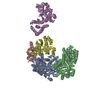
|
|---|---|
| 1 |
|
- Components
Components
| #1: Protein | Mass: 68454.125 Da / Num. of mol.: 2 Mutation: Truncation of the N-terminal domain, UNP residues 1-46 Source method: isolated from a genetically manipulated source Details: N-terminal polyhistidine purification tagTruncation of the binuclear zinc cluster domain Source: (gene. exp.)  Gene: CEP3, CBF3, CBF3B, CSL1, YMR168C, YM8520.17C / Plasmid: Modified pRS426 / Cell line (production host): BCY123 / Production host:  #2: Protein | | Mass: 22558.451 Da / Num. of mol.: 1 Source method: isolated from a genetically manipulated source Source: (gene. exp.)  Gene: SKP1, CBF3D, YDR328C, D9798.14 / Plasmid: Modified pRS426 / Cell line (production host): BCY123 / Production host:  #3: Protein | | Mass: 60899.961 Da / Num. of mol.: 1 Source method: isolated from a genetically manipulated source Details: C-terminal CBP purification tag Source: (gene. exp.)  Gene: CTF13, CBF3C, YMR094W, YM6543.01, YM9582.19 / Plasmid: Modified pRS424 / Cell line (production host): BCY123 / Production host:  #4: Protein | | Mass: 66159.578 Da / Num. of mol.: 1 / Fragment: UNP residues 2-553 Mutation: Construct comprising residues 1-554 with C-terminal Strep tag Source method: isolated from a genetically manipulated source Details: Domains 1-2 of Ndc10 with a non-cleavable C-terminal StrepII tag Source: (gene. exp.)  Gene: CBF2, CBF3A, CEP2, CTF14, NDC10, YGR140W / Plasmid: Modified pRS426 / Cell (production host): BCY123 / Production host:  |
|---|
-Experimental details
-Experiment
| Experiment | Method: ELECTRON MICROSCOPY |
|---|---|
| EM experiment | Aggregation state: PARTICLE / 3D reconstruction method: single particle reconstruction |
- Sample preparation
Sample preparation
| Component | Name: Core CBF3 in complex with Ndc10 D1-2 / Type: COMPLEX Details: The truncated CBF3 complex, recombinantly expressed in Saccharomyces cerevisiae. It comprises a Cep3 homodimer, in which the binuclear zinc cluster domains are truncated, full length ...Details: The truncated CBF3 complex, recombinantly expressed in Saccharomyces cerevisiae. It comprises a Cep3 homodimer, in which the binuclear zinc cluster domains are truncated, full length heterodimer of Skp1 and Ctf13, and a monomeric construct Ndc10 comprising domains 1-2. Entity ID: all / Source: RECOMBINANT | ||||||||||||||||||||
|---|---|---|---|---|---|---|---|---|---|---|---|---|---|---|---|---|---|---|---|---|---|
| Molecular weight | Value: 0.286 MDa / Experimental value: NO | ||||||||||||||||||||
| Source (natural) | Organism:  | ||||||||||||||||||||
| Source (recombinant) | Organism:  | ||||||||||||||||||||
| Buffer solution | pH: 8 | ||||||||||||||||||||
| Buffer component |
| ||||||||||||||||||||
| Specimen | Conc.: 0.15 mg/ml / Embedding applied: NO / Shadowing applied: NO / Staining applied: NO / Vitrification applied: YES Details: The sample is homogeneous and well-dispersed on grids. | ||||||||||||||||||||
| Specimen support | Grid material: GOLD / Grid mesh size: 300 divisions/in. / Grid type: Quantifoil, UltrAuFoil, R1.2/1.3 | ||||||||||||||||||||
| Vitrification | Instrument: FEI VITROBOT MARK I / Cryogen name: ETHANE / Humidity: 100 % / Chamber temperature: 277 K |
- Electron microscopy imaging
Electron microscopy imaging
| Experimental equipment |  Model: Titan Krios / Image courtesy: FEI Company |
|---|---|
| Microscopy | Model: FEI TITAN KRIOS |
| Electron gun | Electron source:  FIELD EMISSION GUN / Accelerating voltage: 300 kV / Illumination mode: FLOOD BEAM FIELD EMISSION GUN / Accelerating voltage: 300 kV / Illumination mode: FLOOD BEAM |
| Electron lens | Mode: BRIGHT FIELD / Calibrated magnification: 47170 X / Cs: 2.7 mm |
| Specimen holder | Cryogen: NITROGEN / Specimen holder model: FEI TITAN KRIOS AUTOGRID HOLDER |
| Image recording | Electron dose: 50 e/Å2 / Detector mode: COUNTING / Film or detector model: GATAN K2 SUMMIT (4k x 4k) / Num. of grids imaged: 1 / Num. of real images: 2003 |
| Image scans | Movie frames/image: 40 / Used frames/image: 1-40 |
- Processing
Processing
| EM software |
| ||||||||||||||||||||||||||||||||||||||||
|---|---|---|---|---|---|---|---|---|---|---|---|---|---|---|---|---|---|---|---|---|---|---|---|---|---|---|---|---|---|---|---|---|---|---|---|---|---|---|---|---|---|
| Image processing | Details: The selected images were high-pass filtered and normalized. | ||||||||||||||||||||||||||||||||||||||||
| CTF correction | Type: PHASE FLIPPING AND AMPLITUDE CORRECTION | ||||||||||||||||||||||||||||||||||||||||
| Particle selection | Num. of particles selected: 214608 Details: Number of particles after selection by 2D classification | ||||||||||||||||||||||||||||||||||||||||
| Symmetry | Point symmetry: C1 (asymmetric) | ||||||||||||||||||||||||||||||||||||||||
| 3D reconstruction | Resolution: 4.2 Å / Resolution method: FSC 0.143 CUT-OFF / Num. of particles: 56509 / Algorithm: FOURIER SPACE / Num. of class averages: 1 / Symmetry type: POINT | ||||||||||||||||||||||||||||||||||||||||
| Atomic model building | Details: "Fit in map" function used to place 6FE8 and 4ACO with out further refinement or model building |
 Movie
Movie Controller
Controller



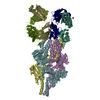
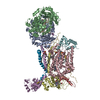


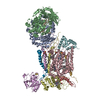

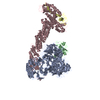
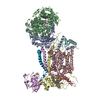
 PDBj
PDBj








